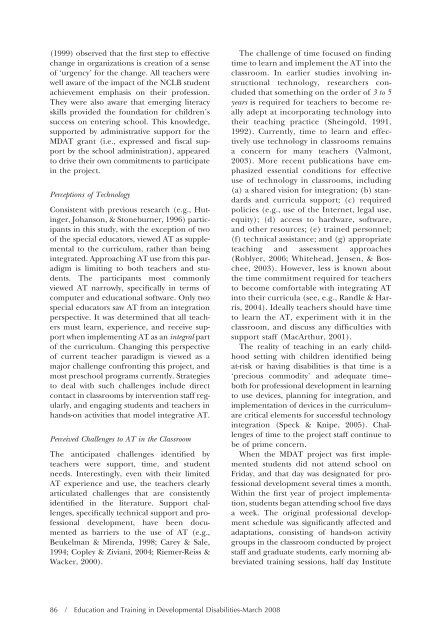Download the Journal (PDF) - Division on Autism and ...
Download the Journal (PDF) - Division on Autism and ...
Download the Journal (PDF) - Division on Autism and ...
You also want an ePaper? Increase the reach of your titles
YUMPU automatically turns print PDFs into web optimized ePapers that Google loves.
(1999) observed that <str<strong>on</strong>g>the</str<strong>on</strong>g> first step to effective<br />
change in organizati<strong>on</strong>s is creati<strong>on</strong> of a sense<br />
of ‘urgency’ for <str<strong>on</strong>g>the</str<strong>on</strong>g> change. All teachers were<br />
well aware of <str<strong>on</strong>g>the</str<strong>on</strong>g> impact of <str<strong>on</strong>g>the</str<strong>on</strong>g> NCLB student<br />
achievement emphasis <strong>on</strong> <str<strong>on</strong>g>the</str<strong>on</strong>g>ir professi<strong>on</strong>.<br />
They were also aware that emerging literacy<br />
skills provided <str<strong>on</strong>g>the</str<strong>on</strong>g> foundati<strong>on</strong> for children’s<br />
success <strong>on</strong> entering school. This knowledge,<br />
supported by administrative support for <str<strong>on</strong>g>the</str<strong>on</strong>g><br />
MDAT grant (i.e., expressed <strong>and</strong> fiscal support<br />
by <str<strong>on</strong>g>the</str<strong>on</strong>g> school administrati<strong>on</strong>), appeared<br />
to drive <str<strong>on</strong>g>the</str<strong>on</strong>g>ir own commitments to participate<br />
in <str<strong>on</strong>g>the</str<strong>on</strong>g> project.<br />
Percepti<strong>on</strong>s of Technology<br />
C<strong>on</strong>sistent with previous research (e.g., Hutinger,<br />
Johans<strong>on</strong>, & St<strong>on</strong>eburner, 1996) participants<br />
in this study, with <str<strong>on</strong>g>the</str<strong>on</strong>g> excepti<strong>on</strong> of two<br />
of <str<strong>on</strong>g>the</str<strong>on</strong>g> special educators, viewed AT as supplemental<br />
to <str<strong>on</strong>g>the</str<strong>on</strong>g> curriculum, ra<str<strong>on</strong>g>the</str<strong>on</strong>g>r than being<br />
integrated. Approaching AT use from this paradigm<br />
is limiting to both teachers <strong>and</strong> students.<br />
The participants most comm<strong>on</strong>ly<br />
viewed AT narrowly, specifically in terms of<br />
computer <strong>and</strong> educati<strong>on</strong>al software. Only two<br />
special educators saw AT from an integrati<strong>on</strong><br />
perspective. It was determined that all teachers<br />
must learn, experience, <strong>and</strong> receive support<br />
when implementing AT as an integral part<br />
of <str<strong>on</strong>g>the</str<strong>on</strong>g> curriculum. Changing this perspective<br />
of current teacher paradigm is viewed as a<br />
major challenge c<strong>on</strong>fr<strong>on</strong>ting this project, <strong>and</strong><br />
most preschool programs currently. Strategies<br />
to deal with such challenges include direct<br />
c<strong>on</strong>tact in classrooms by interventi<strong>on</strong> staff regularly,<br />
<strong>and</strong> engaging students <strong>and</strong> teachers in<br />
h<strong>and</strong>s-<strong>on</strong> activities that model integrative AT.<br />
Perceived Challenges to AT in <str<strong>on</strong>g>the</str<strong>on</strong>g> Classroom<br />
The anticipated challenges identified by<br />
teachers were support, time, <strong>and</strong> student<br />
needs. Interestingly, even with <str<strong>on</strong>g>the</str<strong>on</strong>g>ir limited<br />
AT experience <strong>and</strong> use, <str<strong>on</strong>g>the</str<strong>on</strong>g> teachers clearly<br />
articulated challenges that are c<strong>on</strong>sistently<br />
identified in <str<strong>on</strong>g>the</str<strong>on</strong>g> literature. Support challenges,<br />
specifically technical support <strong>and</strong> professi<strong>on</strong>al<br />
development, have been documented<br />
as barriers to <str<strong>on</strong>g>the</str<strong>on</strong>g> use of AT (e.g.,<br />
Beukelman & Mirenda, 1998; Carey & Sale,<br />
1994; Copley & Ziviani, 2004; Riemer-Reiss &<br />
Wacker, 2000).<br />
86 / Educati<strong>on</strong> <strong>and</strong> Training in Developmental Disabilities-March 2008<br />
The challenge of time focused <strong>on</strong> finding<br />
time to learn <strong>and</strong> implement <str<strong>on</strong>g>the</str<strong>on</strong>g> AT into <str<strong>on</strong>g>the</str<strong>on</strong>g><br />
classroom. In earlier studies involving instructi<strong>on</strong>al<br />
technology, researchers c<strong>on</strong>cluded<br />
that something <strong>on</strong> <str<strong>on</strong>g>the</str<strong>on</strong>g> order of 3to5<br />
years is required for teachers to become really<br />
adept at incorporating technology into<br />
<str<strong>on</strong>g>the</str<strong>on</strong>g>ir teaching practice (Sheingold, 1991,<br />
1992). Currently, time to learn <strong>and</strong> effectively<br />
use technology in classrooms remains<br />
a c<strong>on</strong>cern for many teachers (Valm<strong>on</strong>t,<br />
2003). More recent publicati<strong>on</strong>s have emphasized<br />
essential c<strong>on</strong>diti<strong>on</strong>s for effective<br />
use of technology in classrooms, including<br />
(a) a shared visi<strong>on</strong> for integrati<strong>on</strong>; (b) st<strong>and</strong>ards<br />
<strong>and</strong> curricula support; (c) required<br />
policies (e.g., use of <str<strong>on</strong>g>the</str<strong>on</strong>g> Internet, legal use,<br />
equity); (d) access to hardware, software,<br />
<strong>and</strong> o<str<strong>on</strong>g>the</str<strong>on</strong>g>r resources; (e) trained pers<strong>on</strong>nel;<br />
(f) technical assistance; <strong>and</strong> (g) appropriate<br />
teaching <strong>and</strong> assessment approaches<br />
(Roblyer, 2006; Whitehead, Jensen, & Boschee,<br />
2003). However, less is known about<br />
<str<strong>on</strong>g>the</str<strong>on</strong>g> time commitment required for teachers<br />
to become comfortable with integrating AT<br />
into <str<strong>on</strong>g>the</str<strong>on</strong>g>ir curricula (see, e.g., R<strong>and</strong>le & Harris,<br />
2004). Ideally teachers should have time<br />
to learn <str<strong>on</strong>g>the</str<strong>on</strong>g> AT, experiment with it in <str<strong>on</strong>g>the</str<strong>on</strong>g><br />
classroom, <strong>and</strong> discuss any difficulties with<br />
support staff (MacArthur, 2001).<br />
The reality of teaching in an early childhood<br />
setting with children identified being<br />
at-risk or having disabilities is that time is a<br />
‘precious commodity’ <strong>and</strong> adequate time-both<br />
for professi<strong>on</strong>al development in learning<br />
to use devices, planning for integrati<strong>on</strong>, <strong>and</strong><br />
implementati<strong>on</strong> of devices in <str<strong>on</strong>g>the</str<strong>on</strong>g> curriculum-are<br />
critical elements for successful technology<br />
integrati<strong>on</strong> (Speck & Knipe, 2005). Challenges<br />
of time to <str<strong>on</strong>g>the</str<strong>on</strong>g> project staff c<strong>on</strong>tinue to<br />
be of prime c<strong>on</strong>cern.<br />
When <str<strong>on</strong>g>the</str<strong>on</strong>g> MDAT project was first implemented<br />
students did not attend school <strong>on</strong><br />
Friday, <strong>and</strong> that day was designated for professi<strong>on</strong>al<br />
development several times a m<strong>on</strong>th.<br />
Within <str<strong>on</strong>g>the</str<strong>on</strong>g> first year of project implementati<strong>on</strong>,<br />
students began attending school five days<br />
a week. The original professi<strong>on</strong>al development<br />
schedule was significantly affected <strong>and</strong><br />
adaptati<strong>on</strong>s, c<strong>on</strong>sisting of h<strong>and</strong>s-<strong>on</strong> activity<br />
groups in <str<strong>on</strong>g>the</str<strong>on</strong>g> classroom c<strong>on</strong>ducted by project<br />
staff <strong>and</strong> graduate students, early morning abbreviated<br />
training sessi<strong>on</strong>s, half day Institute
















